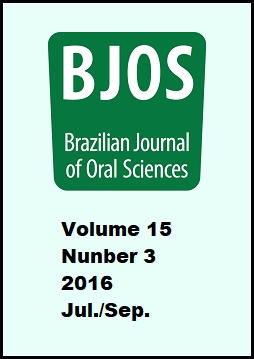Abstract
Aim: Evaluate the dimensional accuracy of stone casts of a partially edentulous mandibular arch made by two impression techniques (1-step putty/light-body and 2-step putty/light-body) using addition and condensation silicones. Methods: A partially edentulous steel stainless cast with four markings on teeth 33, 37, 43, and 47 was used to obtain the impressions. The transverse (33-43 and 37-47) and anteroposterior (33-37 and 43-47) distances were measured by measuring microscope (30x magnification; 0.5μm accuracy). For the 1-step putty/light-body technique, both viscosities of the impression materials were handled together. For the 2-step putty/light-body technique, the impression materials of different viscosities were handled separately and a polypropylene spacer (2 mm thick) was used to create a relief. The same distances were measured om stone casts (n = 5). The values were submitted to normality test (Kolmogorov-Smirnov) and analyzed statistically by three-way ANOVA and Tukey’s (5%). Results: All distances showed shrinkage (negative linear changes). The addition silicones showed better accuracy than condensation silicones (p<0.05) and no significant difference was found between the impression techniques (p>0.05). The edentulous zone (43-47) presented worst dimensional accuracy results. Conclusions: The accuracy of the castsis more related to the impression material than impression technique.References
Thota KK, Jasthi S, Ravuri R, Tella S. Comparative evaluation of dimensional stability of three different elastomeric impression materials – an invitro study. J Clin Diagn Res. 2014 Oct;8(10):ZC48-50. doi: 10.7860/ JCDR/2014/9768.5036.
Varvara G, Murmura G, Sinjari B. Evaluation of defects in surface detail for impression techniques: An in vitro study. J Prosthet Dent. 2015 Feb;113(2):108-13. doi: 10.1016/j.prosdent.2014.08.007.
Vadapalli SB, Atluri K, Putcha MS, Kondreddi S, Kumar NS. Evaluation of surface detail reproduction, dimensional stability and gypsum compatibility of monophase polyvinyl-siloxane and polyether elastomeric impression materials under dry and moist conditions. J Int Soc Prev Community Dent. 2016 Jul-Aug;6(4):302-8. doi: 10.4103/2231-0762.186795.
Shembesh M, Ali A, Finkelman M, Weber HP, Zandparsa R. An in vitro comparison of the marginal adaptation accuracy of CAD/CAM restorations using different impression systems. J Prosthodont. 2016 Feb 8. doi: 10.1111/jopr.12446.
Kotha SB, Ramakrishnaiah R, Devang Divakar D, Celur SL, Qasim S, Matinlinna JP. Effect of disinfection and sterilization on the tensile strength, surface roughness, and wettability of elastomers. J Investig Clin Dent. 2016 Oct 26. doi: 10.1111/jicd.12244.
Caputi S, Varvara G. Dimensional accuracy of resultant casts made by a monophase, one-step and two-step, and a novel two-step putty/ light-body impression technique: an in vitro study. J Prosthet Dent. 2008 Apr;99(4):274-81. doi: 10.1016/S0022-3913(08)60061-X.
Surapaneni H, Samatha P, Shankar R, Attili S. Polyvinylsiloxanes in dentistry: an overview. Trends Biomater Artif Organs. 2013 Jul;27(3):115-23.
Daou E. The elastomers for complete denture impression: a review of the literature. Saudi Dent J. 2010 Oct;22(4):153-60. doi: 10.1016/j. sdentj.2010.07.005.
Reisbick MH. Effect of viscosity on the accuracy and stability of elastic impression materials. J Dent Res. 1973 May-Jun;52(3):407-17.
Myers GE, Stockman DG. The Thiokol rubber impression materials. J Prosthet Dent. 1958;8(2):330-9.
Dugal R, Railkar B, Musani S. Comparative evaluation of dimensional accuracy of different polyvinyl siloxane putty-wash impression techniques-in vitro study. J Int Oral Health. 2013 Oct;5(5):85-94.
Hung SH, Purk JH, Tira DE. Accuracy of one-step versus two-step putty wash addition silicone impression technique. J Prosthet Dent. 1992 May;67(5):583-9.
Mann K, Davids A, Range U, Richter G, Boening K, Reitemeier B. Experimental study on the use of spacer foils in two-step putty and wash impression procedures using silicone impression materials. J Prosthet Dent. 2015 Apr;113(4):316-22. doi: 10.1016/j. prosdent.2014.09.014.
Chee WWL, Donovan TE. Polyvinyl siloxane impression materials: a review of properties and techiniques. J Prosthet Dent. 1992 Nov;68(5):728-32.
Craig RG, Urquiola NJ, Liu CC. Comparison of commercial elastomeric impression materials. Oper Dent. 1990 MayJun;15(3):94-104.
Giordano R. Impression materials: basic properties. Gen Dent. 2000 Sep-Oct;48(5):510-6.
Custer F, Updegrove L, Ward M. Accuracy and dimensional stability of a silicone rubber base impression material. J Prosthet Dent. 1964;14(6):1115-21.
Christensen GJ. What category of impression material is best for your practice? J Am Dent Assoc. 1997 Jul;128(7):1026-8.
McCabe JF, Wilson HJ. Addition cure silicone rubber impression materials. Br Dent J. 1978;145(4):17-20.
Stackhouse Jr. JA. The accuracy of stones die made from rubber impression materials. J Prosthet Dent. 1970 Oct;24(4):377-86.
Valderhaug J, FlØystrand F. Dimensional stability of elastomeric impression materials in custom made and stock trays. J Prosthet Dent. 1984 Oct;52(4):514-7.
Johnson GH, Craig RG. Accuracy of addition silicones as a function of technique. J Prosthet Dent. 1986 Feb;55(2):197-203.
Pande NA, Parkhedkar. An evaluation of dimensional accuracy of one-step and two-step impression technique using addition silicone impression material: an in vitro study. J Indian Prosthodont Soc. 2013 Sep;13(3):254-9. doi: 10.1007/s13191-012-0182-1.
Nirmala K, Nandeeshwar B. The dimensional accuracy of polivinyl siloxane impression materials using two different impression techniques: An in vitro study. J Indian Prosthodont Soc. 2015 JulSep;15(3):211-7. doi: 10.4103/0972-4052.158074.
Nissan J, Rosner O, Bukhari MA, Ghelfan O, Pilo R. Effect of various putty-wash impression techniques on marginal fito of cast crowns. Int J Periodontics Restorative Dent. 2013 Jan-Feb;33(1):e37-42.
Abbade DA, Nakandakari S, Mendes AJ. [Moulds in fixed partial prosthesis: comparative amalysis of two mouldding techmiques using sylicon based material to verify oclusal areas with dimens anal alterations in tee prepared to receive the prosthesis]. RGO. 1983 JanMar;31(1):11-4. Portuguese.
Singh K, Sahoo S, Prasad KD. Effect of different impressions techniques on the dimensional accuracy of impresions using various elastomeric impression materials: An in vitro study. J Contemp Dent Pract. 2012 Jan;13(1):98-106.
The Brazilian Journal of Oral Sciences uses the Creative Commons license (CC), thus preserving the integrity of the articles in an open access environment.

